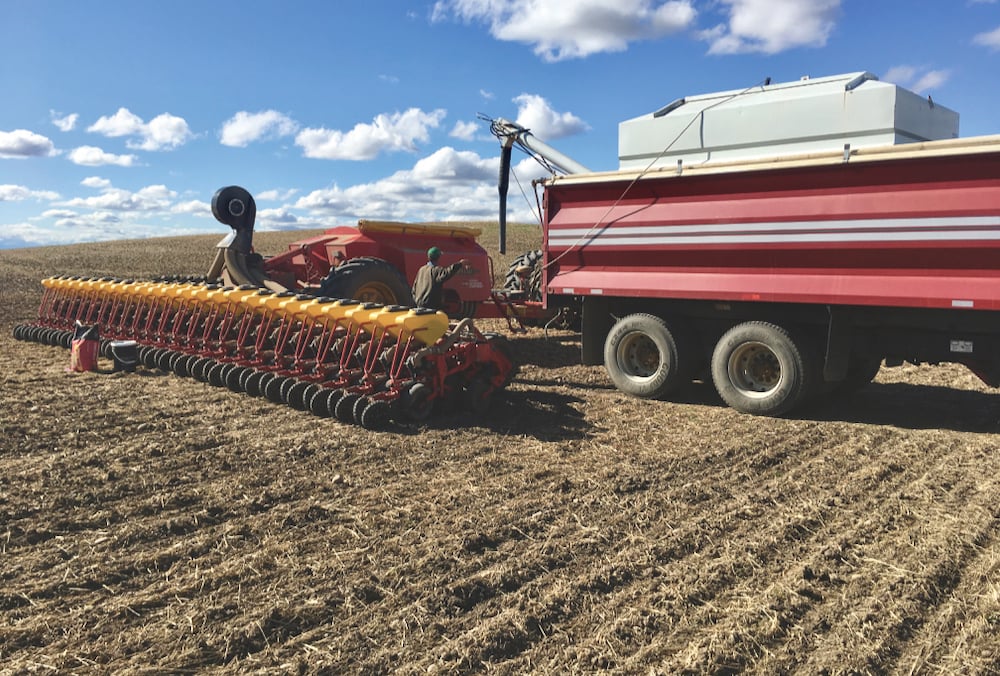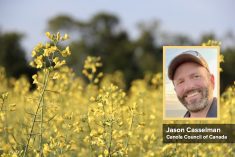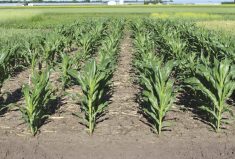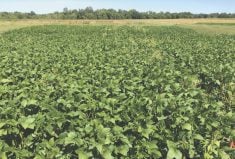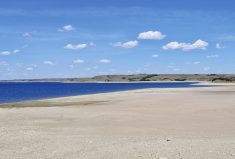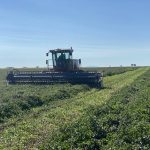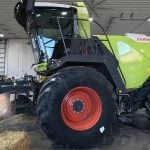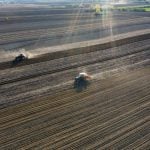When asked for his canola seeding rate, Edmund Rath answers “260,000 seeds per acre.” This is not the usual answer. Five pounds per acre, give or take a pound, is the common response. “After May 15, I cut that down to 240,000,” he adds.
Here’s a quick translation: With 43,560 square feet in an acre, Rath’s higher seeding rate is equal to six seeds per square foot and his late-May warm-soil seeding rate is 5.5 seeds per square foot. If seed weight is five grams per 1,000, for example, that would be three pounds per acre.
Rath speaks the language of planters, and a planter is precisely what the farmer from Rolla, B.C. uses to seed … precisely.
Read Also

Ontario farmers partner for success
Ontario business partners, Matt Bergman and DJ Wassenaar, have been farming together for 10 years. Their focus on integrating unconventional…
Jason Casselman, the Canola Council of Canada agronomy specialist for the Peace region, also speaks planter. He worked in Ontario before moving out west in 2005, and he says it was an adjustment to hear farmers on the Prairies talk about seeding rates in pounds. “Planter users always talk about seeds per acre, like corn rates of 30,000 kernels and even winter wheat rates of 1.8 million seeds per acre,” Casselman says. “When the goal is a certain number of plants, it makes sense to set rates based on how many seeds you need to meet that goal.”
Rath seeds canola with a Väderstad Tempo L 24 planter on 17.5-inch row spacing and seeds yellow peas, barley and hard red spring with his older Flexi-Coil 5000 air seeder. He bought the Väderstad four years ago and ran on-farm trials the first two years to settle on an appropriate seeding rate. He compared six rates, ranging from 180,000 to 260,000 seeds per acre, in 20-acre plots. “At harvest, moisture content and yield for all six were basically the same,” he says, “but 200,000 looks pretty thin.”
So he stuck with the higher rates. “We’re not the gambling types,” he says. “I don’t want to go too low in case we lose plants to frost or flea beetles.”
Studies show that canola stands with fewer than four plants per square foot will almost always have yield loss compared to crops with populations of four plants or more. The Canola Council of Canada recommended target of five to eight plants per square foot provides a little insurance in case of frost, flea beetles or other factors that remove a few plants. In order to hit the five-to-eight-plant target, Rath needs almost all of his 5.5 to 6 seeds per square foot to survive and form plants. And they do. “Our emergence rate is 88 to 93 per cent,” he says.
How planters can increase crop emergence
Rath bought the planter because he wasn’t happy with canola emergence rates using his air seeder. “Even at 4.5 to 4.8 miles per hour, we would have clumps of seed then skips of five, six, seven inches with nothing,” he says. Emergence rates, he says, were 50 to 60 per cent, which are actually in line with the Canadian average. But that’s not good enough for him.
Casselman says uniform depth and seed spacing from a planter can do a lot to boost emergence rates.
“Seeds that go too deep can see increased mortality due to reduced seedling vigour and extended exposure to seeding diseases, and seeds that are crowded in the row will not all survive to form viable plants.”

The Tempo uses a pressurized hopper to push seeds into the metering disc and down the seed tube. A “stopping wheel” at the end of the tube releases each seed into the soil at precise intervals. Rath gets good results at an operating speed of 6.8 m.p.h. “Once you find the first seed, every 1.5 inches you’ll find the next one,” Rath says.
The monitor also counts every seed that drops, so if Rath sets a target of 260,000 seeds per acre, that’s how many the planter will put in the ground. The monitor includes skips and doubles in its counts.
One warning from Rath: The Tempo needs really clean seed. “Seed treatment fines will plug the holes,” he says. Rath works closely with the seed company Canterra to source seed cleaned to his specifications.
Candace Reinbold is Canterra’s territory manager for the Peace region of northern B.C. and Alberta. Canterra works with a few planter users like Rath to make sure its seed product will be a suitable match for the technology. “As a smaller seed company, we have had the ability in the past to tailor orders for growers like the Raths,” Reinbold says. “Feedback from these growers help us, as an industry, to improve our technology and bagging operations to bring more uniform size and weight seed to our growers.”
The Tempo has an on-board bulk fertilizer tank that holds six tonnes of product. Rath uses it to apply phosphate in the spring at the time of seeding. Fertilizer goes down through a separate disc opener two inches to the side of the seed disc. For the rest of his fertilizer, Rath deep-bands (to a four-inch depth) nitrogen, potassium and sulphur in the fall. In the spring, he goes over the fields with a heavy harrow to level the field for the planter. These steps to manage residue and keep fertilizer away from the seed can also improve emergence percentages.
Rath starts seeding canola around May 8, so not too early. His soil is grey-wooded clay with a range of 3.5 to six per cent organic matter. It has “hardly any rocks,” he says, which is important for a planter. “I’m not sure about planters in areas with a lot of rocks.”
The planter has lots of adjustments, he says, so he can set seeding depth to reach moisture and packing pressure to keep that moisture sealed in.
And finally, while the planter is only 32 feet wide, the possibility to achieve precise seed placement at higher speeds means he can still seed about 250 acres of canola a day.
“There is more and more talk about using a planter for canola,” Rath says, adding that higher emergence percentage and saving on seed are major benefits. “A farmer should at least look at it.”
Calculate the right seeding rate
Using the 1,000-seed weight (TSW) on the seed bag, along with the farmer’s target plant density and estimated emergence, the Canola Council of Canada’s Seeding Rate and Seed Cost Calculator will determine the appropriate seeding rate (in the familiar pounds per acre) as well as cost per acre of the canola seed. Find the tool at canolacalculator.ca. Farmers can adjust the estimated emergence percentage to see the potential seed cost savings when they take steps to improve emergence rates.
How to increase canola seed survival rates
Try these tips to improve emergence percentage so more canola seeds contribute to yield and profitability.
- Seed shallow. Half an inch to one inch below the packer furrow is the recommended seed depth for canola.
- Seed at a consistent depth. Maintain the drill to ensure all openers work at the same depth.
- Seed slower. At higher speeds, rear openers tend to throw more soil over the front rows, making these seeds slower to emerge.
- Limit seed-placed fertilizer. The safest practice is to place only phosphate fertilizer with the seed at rates up to 20 pounds per acre.
- Penetrate residue. Use openers and drill settings to penetrate residue so all seeds go into the soil.
- Pack appropriately. In wet conditions, reduce packing pressure to limit hard crusting. In dry conditions, pack more to seal moisture in the seed row.
- Seed into warmer soils. Soil temperatures of 5 C or higher with warmer weather in the forecast should facilitate reasonably good rates of emergence.
- Rotate crops. A tight canola rotation could increase the risk from seed and seedling diseases that can prevent emergence or weaken the young plants.
For more details, including useful links, please read the article “How to increase canola seed survival rates” in the Fundamentals section at canolawatch.org.

